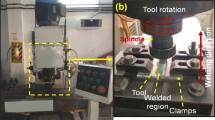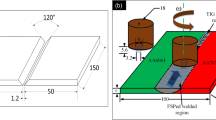Abstract
The quality of friction stir welding joints is intimately related to the correct mixing of the stirred material. The material flow is strongly dependent on the plastic behavior of the welded alloy. For this reason, the friction stir weldability depends on the structure, microstructure, and chemical composition of the base material. In this work, in-plane forces and acoustic emission signals were monitored while welding two heat-treatable aluminum alloys. The force evolutions suggested possible continuous and intermittent material flow during friction stir welding depending on the welding parameters. The differences observed in the in-plane forces were corroborated by acoustic emission, confirming the modification in the material flow phenomenology. Therefore, differences observed in aluminum alloys’ friction stir weldability are due to the plastic behavior at high temperature and medium-high strain rate. The higher the deformability of the aluminum alloys, the wider the weldability window in friction stir welding because of continuous material flow in an extended range of process parameters.




















Similar content being viewed by others

References
Thomas WM, Nicholas ED, Needham JC, Murch MG, Templesmith P, Dawes CJ (1995) U.S. Patent No. 5,460,317, October 24
Engler O, Hirsch J (2002) Texture control by thermomechanical processing of AA6xxx Al-Mg-Si sheet alloys for automotive applications - a review. Mater Sci Eng A 336(1-2):249–262. https://doi.org/10.1016/S0921-5093(01)01968-2
Ribeiro FC, Scarpin BT, Batalha GF (2016) Experimental and numerical modelling and simulation of the creep age forming of aeronautic panels AA7XXX aluminium alloy. Adv Mater Process Technol 2 (1):1–20. https://doi.org/10.1080/2374068X.2016.1147764
Cavaliere P, Squillace A, Panella F (2008) Effect of welding parameters on mechanical and microstructural properties of AA6082 joints produced by friction stir welding. J Mater Process Technol 200(1-3):364–372. https://doi.org/10.1016/j.jmatprotec.2007.09.050
Leitão C, Louro R, Rodrigues DM (2012) Analysis of high temperature plastic behaviour and its relation with weldability in friction stir welding for aluminium alloys AA5083-H111 and AA6082-T6. Mater Des 37:402–409. https://doi.org/10.1016/j.matdes.2012.01.031
Ramulu PJ, Narayanan RG, Kailas SV, Reddy J (2013) Internal defect and process parameter analysis during friction stir welding of Al 6061 sheets. Int J Adv Manuf Technol 65(9-12):1515–1528. https://doi.org/10.1007/s00170-012-4276-z
Forcellese A, Simoncini M, Casalino G (2017) Influence of process parameters on the vertical forces generated during friction stir welding of AA6082-T6 and on the mechanical properties of the joints. Metals 7 (9):1–13. https://doi.org/10.3390/met7090350
Lambiase F, Paoletti A, Di Ilio A (2018) Forces and temperature variation during friction stir welding of aluminum alloy AA6082-T6. Int J Adv Manuf Technol 99(1-4):337–346. https://doi.org/10.1007/s00170-018-2524-6
Azimzadegan T, Serajzadeh S (2010) An investigation into microstructures and mechanical properties of AA7075-T6 during friction stir welding at relatively high rotational speeds. J Mater Eng Perform 19 (9):1256–1263. https://doi.org/10.1007/s11665-010-9625-1
Bahemmat P, Besharati MK, Haghpanahi M, Rahbari A, Salekrostam R (2010) Mechanical, micro-, and macrostructural analysis of AA7075-T6 fabricated by friction stir butt welding with different rotational speeds and tool pin profiles. Proc Inst Mech Eng B J Eng Manuf 224(3):419–433. https://doi.org/10.1243/09544054JEM1554
Gemme F, Verreman Y, Dubourg L, Wanjara P (2011) Effect of welding parameters on microstructure and mechanical properties of AA7075-T6 friction stir welded joints. pp 877–886. https://doi.org/10.1111/j.1460-2695.2011.01580.x
Rajakumar S, Muralidharan C, Balasubramanian V (2011) Influence of friction stir welding process and tool parameters on strength properties of AA7075-T6 aluminium alloy joints. Mater Des 32(2):535–549. https://doi.org/10.1016/j.matdes.2010.08.025
Ipekoǧlu G, Kiral BG, Erim S, Çam G (2012) Investigation of the effect of temper condition on the friction-stir weldability of AA7075 Al-alloy plates. Mater Tehnol 46(6):627–632
Zhang C, Huang G, Cao Y, Zhu Y, Liu Q (2019) On the microstructure and mechanical properties of similar and dissimilar AA7075 and AA2024 friction stir welding joints: Effect of rotational speed. J Manuf Process 37(December 2018):470–487. https://doi.org/10.1016/j.jmapro.2018.12.014
Ambrosio D, Wagner V, Garnier C, Jacquin D, Tongne A, Fazzini M, Dessein G (2020) Influence of welding parameters on the microstructure, thermal fields and defect formation in AA7075-T6 friction stir welds. Weld World 64(5):773–784. https://doi.org/10.1007/s40194-020-00869-4
Ambrosio D, Garnier C, Wagner V, Aldanondo E, Dessein G, Cahuc O (2020) Relationships between welding parameters, aging conditions, and weld properties in AA7075-T6 friction stir welds. Int J Adv Manuf Technol 111(5-6):1333–1350. https://doi.org/10.1007/s00170-020-06184-y
Long T, Tang W, Reynolds AP (2007) Process response parameter relationships in aluminium alloy friction stir welds. Sci Technol Weld Join 12(4):311–317. https://doi.org/10.1179/174329307X197566
Astarita A, Squillace A, Carrino L (2014) Experimental study of the forces acting on the tool in the friction-stir welding of AA 2024 T3 sheets. J Mater Eng Perform 23(10):3754–3761. https://doi.org/10.1007/s11665-014-1140-3
Doude H, Schneider J, Patton B, Stafford S, Waters T, Varner C (2015) Optimizing weld quality of a friction stir welded aluminum alloy. J Mater Process Technol 222:188–196. https://doi.org/10.1016/j.jmatprotec.2015.01.019
Shrivastava A, Zinn M, Duffie NA, Ferrier NJ, Smith CB, Pfefferkorn FE (2017) Force measurement-based discontinuity detection during friction stir welding. J Manuf Process 26:113–121. https://doi.org/10.1016/j.jmapro.2017.01.007
Franke D, Rudraraju S, Zinn M, Pfefferkorn FE (2020) Understanding process force transients with application towards defect detection during friction stir welding of aluminum alloys. J Manuf Process 54(November 2019):251–261. https://doi.org/10.1016/j.jmapro.2020.03.003
Chen C, Kovacevic R, Jandgric D (2003) Wavelet transform analysis of acoustic emission in monitoring friction stir welding of 6061 aluminum. Int J Mach Tools Manuf 43(13):1383–1390. https://doi.org/10.1016/S0890-6955(03)00130-5
Soundararajan V, Atharifar H, Kovacevic R (2006) Monitoring and processing the acoustic emission signals from the friction-stir-welding process. Proc Inst Mech Eng B J Eng Manuf 220(10):1673–1685. https://doi.org/10.1243/09544054JEM586
Rajashekar R, Rajaprakash BM (2016) Development of a model for friction stir weld quality assessment using machine vision and acoustic emission techniques. J Mater Process Technol 229:265–274. https://doi.org/10.1016/j.jmatprotec.2015.09.030
Metals Handbook (1990) Vol.2 - properties and selection: nonferrous alloys and special-purpose materials, 10th edn. ASM International, Russell
Wang PL, Jiang HT, Zhang RJ, Huang SY (2016) Study of Hot Deformation Behavior of 6082 Aluminum Alloy. Mater Sci Forum 877:340–346. https://doi.org/10.4028/www.scientific.net/msf.877.340
Cadoni E, Dotta M, Forni D, Kaufmann H (2016) Effects of strain rate on mechanical properties in tension of a commercial aluminium alloy used in armour applications. Procedia Struct Integr 2:986–993. https://doi.org/10.1016/j.prostr.2016.06.126
Ulysse P (2002) Three-dimensional modeling of the friction stir-welding process. Int J Mach Tools Manuf 42(14):1549–1557. https://doi.org/10.1016/S0890-6955(02)00114-1
Mijajlović MM, Pavlović NT, Jovanović SV, Jovanović DS, Milčić MD (2013) Experimental studies of parameters affecting the heat generation in friction stir welding process. Therm Sci 16 (SUPPL.2):351–362. https://doi.org/10.2298/TSCI120430174M
Schmidt H, Hattel J, Wert J (2004) An analytical model for the heat generation in friction stir welding. Model Simul Mater Sci Eng 12(1):143–157. https://doi.org/10.1088/0965-0393/12/1/013
Khandkar MZH, Khan JA, Reynolds AP (2003) Prediction of temperature distribution and thermal history during friction stir welding: input torque based model. Sci Technol Weld Join. https://doi.org/10.1179/136217103225010943
Fehrenbacher A, Duffie NA, Ferrier NJ, Pfefferkorn FE, Zinn MR (2014) Effects of tool-workpiece interface temperature on weld quality and quality improvements through temperature control in friction stir welding. Int J Adv Manuf Technol 71(1-4):165–179. https://doi.org/10.1007/s00170-013-5364-4
Jlaiel K, Yahiaoui M, Paris JY, Denape J (2020) Tribolumen: A tribometer for a correlation between ae signals and observation of tribological process in real-time-application to a dry steel/glass reciprocating sliding contact. Lubricants 8(4). https://doi.org/10.3390/LUBRICANTS8040047
Yahiaoui M, Chabert F, Paris JY, Nassiet V, Denape J (2019) Friction, acoustic emission, and wear mechanisms of a PEKK polymer. Tribol Int 132:154–164. https://doi.org/10.1016/j.triboint.2018.12.020
Silva-Magalhães A, De Backer J, Martin J, Bolmsjö G (2019) In-situ temperature measurement in friction stir welding of thick section aluminium alloys. J Manuf Process 39(February):12–17. https://doi.org/10.1016/j.jmapro.2019.02.001
Yan JH, Sutton MA, Reynolds AP (2007) Processing and banding in AA2524 and AA2024 friction stir welding. Sci Technol Weld Join 12(5):390–401. https://doi.org/10.1179/174329307X213639
Shah LH, Walbridge S, Gerlich A (2019) Tool eccentricity in friction stir welding: a comprehensive review. Sci Technol Weld Join 24(6):566–578. https://doi.org/10.1080/13621718.2019.1573010
Zakharov VV (1995) Scientific aspects of deformability of aluminum alloys during extrusion. Adv Perform Mater 2(1):51–65. https://doi.org/10.1007/BF00711651
Reza A, Zhou J, Duszczyk J (2011) Microstructural evolution during the homogenization of Al-Zn-Mg aluminum alloys. Recent Trends in Processing and Degradation of Aluminium Alloys. https://doi.org/10.5772/34695
Ngernbamrung S, Suzuki Y, Takatsuji N, Dohda K (2018) Investigation of surface cracking of hot-extruded AA7075 billet. Procedia Manuf 15:217–224. https://doi.org/10.1016/j.promfg.2018.07.212
Sigworth GK (1996) Hot tearing of metals. AFS Trans-Am Foundry: 1053–1062. Retrieved from papers3://publication/uuid/ 85386CF4-29C7-4099-94CA-3244BD680230
Stoloff NS (1983) Liquid and solid metal ebrittlement. Atomics of fracture, pp 921–947
Kim YG, Fujii H, Tsumura T, Komazaki T, Nakata K (2006) Three defect types in friction stir welding of aluminum die casting alloy. Mater Sci Eng A 415(1-2):250–254. https://doi.org/10.1016/j.msea.2005.09.072
Funding
This project received funding from the European Union’s Marie Skodowska-Curie Actions (MSCA) Innovative Training Networks (ITN) H2020-MSCA-ITN-2017 under the grant agreement No. 764979.
Author information
Authors and Affiliations
Corresponding author
Ethics declarations
Ethics approval
Not applicable
Consent for Publication
I am agreeing to publish this work.
Competing interests
The authors declare no competing interests.
Additional information
Author contributions
Danilo Ambrosio: conceptualization, methodology, formal analysis, investigation, data curation, writing—original draft, writing—review and editing, visualization. Vincent Wagner: conceptualization, methodology, formal analysis, writing—review and editing. Gilles Dessein: conceptualization, methodology, formal analysis, investigation, writing—review and editing, supervision, project administration. Jean-Yves Paris: writing—review and editing. Kholoud Jlaiel: writing—review and editing. Olivier Cahuc: writing—review and editing, supervision, project administration, funding acquisition.
Consent to participate
I am agreeing to participate.
Publisher’s note
Springer Nature remains neutral with regard to jurisdictional claims in published maps and institutional affiliations.
Rights and permissions
About this article
Cite this article
Ambrosio, D., Wagner, V., Dessein, G. et al. Plastic behavior-dependent weldability of heat-treatable aluminum alloys in friction stir welding. Int J Adv Manuf Technol 117, 635–652 (2021). https://doi.org/10.1007/s00170-021-07754-4
Received:
Accepted:
Published:
Issue Date:
DOI: https://doi.org/10.1007/s00170-021-07754-4



